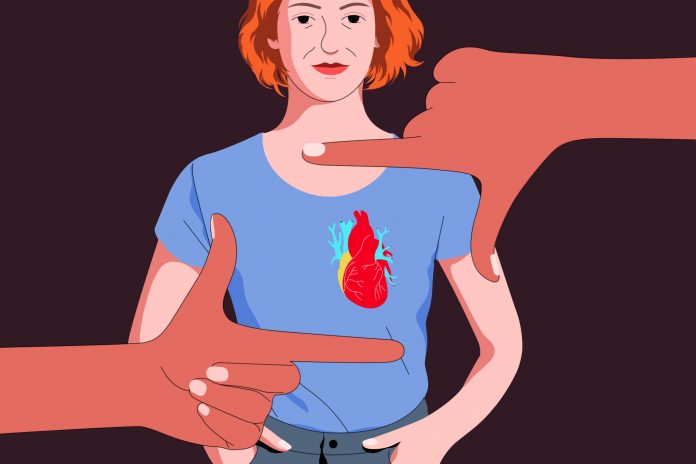Heart attacks — also called myocardial infarctions — are very common in the United States. In fact, one happens every 40 seconds, according to the Centers for Disease Control and Prevention (CDC).
Chest pain is the most common warning sign of a heart attack. But there can be other symptoms, too, like lightheadedness, nausea, and shortness of breath. Symptoms can be severe or mild, and are often different from one person to the next. Some people may not even notice any warning signs of a heart attack.
This article will take a closer look at the causes, symptoms, and risk factors of a heart attack, as well as how a heart attack is diagnosed and treated.
What is a heart attack?
A heart attack happens when blood flow to the heart is blocked or cut off. If there’s not sufficient oxygen-rich blood flowing to the heart, it can cause damage to the affected area. As a result, the heart muscle begins to die.
When your heart isn’t getting the blood and oxygen it needs to function properly, it can put you at a higher risk of heart failure and other serious complications.
A heart attack is a life threatening medical emergency. The sooner you can get medical treatment that restores normal blood flow to your heart, the better your chance of a successful outcome.
Heart attack symptoms
General symptoms for a heart attack can include:
chest pain or discomfort
shortness of breath
pain in your arm, shoulder, or neck
nausea
sweating
lightheadedness or dizziness
fatigue
upper body pain
trouble breathing
Anyone experiencing any of the above heart attack symptoms should contact emergency services immediately.
How heart attack symptoms vary between men and women
Many people experience a mix of heart attack symptoms regardless of sex or gender. However, there are sex-specific differences in the presentation, biology, and outcomes of heart attacks.
A 2019 found that chest pain was the most common symptom in both men and women. With women, the pain is often described as tightness, squeezing, or pressure in the chest, while men tend to describe it as a “heavy weight on the chest.”
According to the American Heart Association (AHA), women are somewhat more likely than men to experience the following heart attack symptoms:
shortness of breath
nausea, vomiting
pain in the upper back or jaw
dizziness or lightheadedness
extreme fatigue
Higher levels of estrogen can reduce the risk of a heart attack. As a result, women have a greater risk of a heart attack after menopause than before menopause.
However, women who have a heart attack are more at risk of underdiagnosis and undertreatment.
For example, a 2018 Swiss study found that women tend to wait longer to contact emergency services after experiencing typical heart attack symptoms. Researchers also found that women tend to experience greater delays in receiving treatment in emergency settings.
How heart attack symptoms may differ for people with diabetes
Research has shown that people with diabetes are more likely to have silent heart attacks compared to people who don’t have diabetes. In other words, if you have diabetes, you may not experience the typical symptoms associated with a heart attack, especially chest pain.
Many studies have been done to better understand why people with diabetes are less likely to experience chest pain and other heart attack symptoms. One explanation is that the development of neuropathy — a type of nerve damage that’s a common complication of diabetes — may interfere with the ability to feel chest pain caused by a heart attack.
According to , approximately 55 percent of people with diabetes have coronary artery disease. Having impaired blood flow in the coronary arteries is a major risk factor for a heart attack.
Because of this risk, it’s important that people with diabetes keep their blood sugar levels under control, get frequent blood tests to check cholesterol levels, and work closely with a doctor to ensure their diabetes is managed well.
Angina vs heart attacks
Chest pain caused by reduced blood flow to the heart muscle is called angina. It’s a common symptom of heart disease. There are two main types of angina:
stable angina, the most common type of angina and one that is predictable — often occurring with physical exertion or stress
unstable angina, which is unpredictable and should be treated as a medical emergency
An angina attack can feel like a heart attack, and in many cases — especially with unstable angina — it can be hard to tell angina from an actual heart attack.
If you have stable angina that’s brought on with exertion and eases with rest, you may assume a sudden — but brief — bout of chest pain is only an angina attack. If chest pain doesn’t subside with rest or comes and goes for a period of 10 minutes or more, you may be having a heart attack.
Talking with your doctor about how to manage your angina will help you better understand the difference between angina and heart attack symptoms, and help prepare you if your chest pain is actually a symptom of a heart attack.
Heart attack causes
The leading cause of heart attacks is coronary heart disease. This is where plaque builds up in the arteries that supply blood to the heart. The general buildup of plaque in the arteries is also known as atherosclerosis.
There are two main types of heart attack.
Type I heart attacks are where plaque on the inner wall of the artery ruptures and releases cholesterol and other substances into the bloodstream. This can then form a blood clot and block the artery.
In type II heart attacks the heart does not receive as much oxygen-rich blood as it needs, but there is not a complete blockage of an artery.
Other causes of heart attacks include:
torn blood vessels
blood vessel spasms
drug misuse
hypoxia, lack of oxygen in the blood
Heart attack risk factors
Several factors can put you at risk for a heart attack. You can’t change some factors, such as age and family history. However, you can make changes related to modifiable risk factors.
Modifiable risk factors that you can help control include:
smoking
high cholesterol
obesity
lack of exercise
high levels of stress
diabetes or prediabetes
eating a diet high in trans fats and saturated fats
excessive alcohol consumption
sleep apnea
Heart disease is the leading cause of death among most ethnic and racial groups in the United States and the most common cause of heart attacks.
It accounts for 23.7 percent of all deaths among white non-Hispanic Americans and 23.5 percent among Black non-Hispanic Americans, according to the CDC. Both figures are marginally higher than the overall population level of 23.4 percent.
If you’re over 65 years old, your risk of having a heart attack is greater than people who are under age 65, according to the National Institute on Aging. This is particularly the case for women.
Also, if you have a family history of heart disease, high blood pressure, high cholesterol, obesity, or diabetes, you may have a higher risk of having a heart attack.
How is a heart attack diagnosed?
Doctors typically diagnose a heart attack after they perform a physical exam and review your medical history. Your doctor will likely conduct an electrocardiogram (ECG) to check your heart’s electrical activity.
An echocardiogram, which uses sound waves to create an image of the heart’s chambers and valves, can reveal how blood is flowing through the heart and what parts of the heart, if any, have been damaged.
Your doctor may also order a cardiac catheterization. This is a probe inserted into the blood vessels through a flexible tube called a catheter. It allows your doctor to view areas in and around your heart where plaque may have built up. They can also inject dye into your arteries, order an X-ray to see how the blood flows, and view any blockages.
Your healthcare team will likely also take a sample of your blood or perform other tests to see if there’s evidence of heart muscle damage.
A commonly used blood test checks for levels of troponin T, a protein found in the heart muscle. Elevated levels of troponin T in the bloodstream is associated with a heart attack.
Treatments
If you’ve had a heart attack, your doctor may recommend a procedure (surgery or nonsurgical). These procedures can relieve pain and help prevent another heart attack from occurring.
Common procedures include:
Stent. A stent is a wire mesh tube surgeons insert into the artery to keep it open after angioplasty.
Angioplasty. An angioplasty opens the blocked artery by using a balloon or by removing the plaque buildup. It’s important to note that healthcare professionals rarely use angioplasty alone anymore.
Heart bypass surgery. In bypass surgery, your doctor reroutes the blood around the blockage.
Heart valve surgery. In valve repair or replacement surgery, surgeons repair or replace leaky valves to help the heart pump.
Pacemaker. A pacemaker is a device implanted beneath the skin. It can help your heart maintain a normal rhythm.
Heart transplant. Surgeons may recommend a heart transplant in cases where a heart attack causes permanent tissue death to most of the heart.
Your doctor may also prescribe medications to treat your heart attack, including:
aspirin
other drugs to break up clots
antiplatelet and anticoagulants, also known as blood thinners
pain relievers
nitroglycerin
blood pressure medication
beta-blockers
The timing of getting treatment is crucial with a heart attack. The sooner you get treatment after having a heart attack, the more quickly blood flow can be restored to the affected part of your heart, and the more successful the outcome is likely to be.
Doctors who treat heart attacks
Since heart attacks are often unexpected, an emergency room doctor is usually the first healthcare professional to treat a heart attack. Once you’re stable, you’ll be transferred to a doctor called a cardiologist who specializes in conditions that affect the heart.
Alternative treatments
Alternative treatments and lifestyle changes can improve your heart health and reduce your risk of a heart attack. A nutrient-rich, balanced diet and a health-promoting lifestyle are essential for maintaining a healthy heart.
How to help someone having a heart attack
If you are with someone who’s experiencing symptoms of a heart attack, call emergency services immediately and follow the instructions they give you regarding what to do.
If the person isn’t responsive and doesn’t have a pulse, doing cardiopulmonary resuscitation (CPR) or using an automated external defibrillator (AED) can be lifesaving.
Most businesses and many public places have AEDs, but if one isn’t present, CPR shouldn’t be delayed. Giving CPR can help pump oxygenated blood through a person’s body until emergency services arrive.
The sooner a person can get emergency medical attention, the less damage their heart muscle will likely sustain.
What should you do if you have a heart attack?
If you suspect you’re having a heart attack, the AHA advises calling 911 immediately (if you live in the United States), rather than attempting to drive yourself to the hospital. If you live outside the United States, call the number that’s associated with your emergency medical services.
Paramedics can begin treating you when they arrive and monitor you on the way to the emergency department.
Even if you’re not sure whether you’re having a heart attack, it’s best to err on the side of caution. When your symptoms start, chew an adult aspirin — unless you are allergic. The anti-platelet qualities of an aspirin may help break up the clot that might be blocking blood flow to your heart.
If possible, reach out to a family member, friend, or neighbor to be with you while you wait for the ambulance or while you are treated at the hospital.
Heart attack complications
Heart attacks can result in various complications. When a heart attack occurs, it can disrupt your heart’s normal rhythm, potentially stopping it altogether. These abnormal rhythms are known as arrhythmias.
When your heart stops getting a supply of blood during a heart attack, some of the heart tissue can die. This can weaken your heart and cause serious complications such as heart failure.
Heart attacks can also affect your heart valves and cause leaks.
The long-term effects on your heart will be determined by how much time it takes to receive medical treatment and how much of your heart has been damaged from the heart attack.
Recovery
A heart attack can damage your heart muscles and impact their function. This can include changing your heart’s rhythm and reducing its ability to pump blood effectively to all the organs and tissues in your body.
Following a heart attack, it’s important to work with your healthcare team to design a recovery plan. This plan may include the following lifestyle changes:
participating in light or moderate exercise, according to what your doctor approves
eating a nutrient-dense, balanced diet low in saturated and trans fats
losing weight if you’re carrying extra weight
quitting smoking if you smoke
monitoring your blood sugar levels closely if you have diabetes
taking steps to keep your blood pressure and cholesterol within a healthy range
avoiding strenuous activities, especially shortly after the heart attack
undergoing cardiac rehabilitation
Heart attack prevention
While there are many risk factors that you cannot control, there are some basic steps you can take to help keep your heart healthy. Here are few examples:
Eat a healthy, balanced diet. Try to incorporate nutrient-rich foods in your diet as often as possible. Focus on lean proteins, whole grains, fruit, vegetables, low-fat dairy, nuts, and seeds. Try to limit fatty, fried foods and foods that contain simple sugars like sodas, baked goods, and white bread.
Exercise regularly. Try to get at least 150 minutes of physical activity a week for optimum heart health.
Quit smoking. If you smoke, consider talking with your doctor about starting a smoking cessation program. Quitting smoking can help reduce your risk because smoking is a major cause of heart disease.
Limit your alcohol intake. Moderation is key when it comes to alcohol and heart health. Light to moderate alcohol consumption is defined as one drink per day for women and two drinks per day for men.
Get your cholesterol levels checked. If your LDL cholesterol or triglycerides are higher than they should be, talk with your doctor about what you need to do to lower your cholesterol and triglycerides.
Manage diabetes. If you have diabetes, take your medications as your doctor prescribed and check your blood glucose levels regularly.
Work with your doctor. If you have a heart condition, work closely with your doctor and follow your treatment plan, which includes taking your medications.
All of these steps are important in lowering your risk of developing heart disease and potentially having a heart attack. Talk with your doctor if you have concerns about your risk of a heart attack.
Every year, an estimated 805,000 people in the United States have a heart attack, the vast majority of which are first-time heart attacks, according the CDC. And while most people who have a heart attack survive, it’s important to know how how to reduce your risk and how to respond if you experience symptoms of a heart attack.
While chest pain is the most common symptom, it’s only one of several common signs of a heart attack. If you think you may be having a heart attack, call for emergency medical help immediately. The sooner you get treatment for a heart attack, the better the outcome will likely be.
There are several tests that can diagnose whether you’ve had a heart attack. If the tests show you’ve had a heart attack, there are effective treatments that can help restore blood flow to your heart and minimize complications.
If you have any risk factors for a heart attack, talk with your doctor about steps you can take to lower your risk of a heart attack.
























